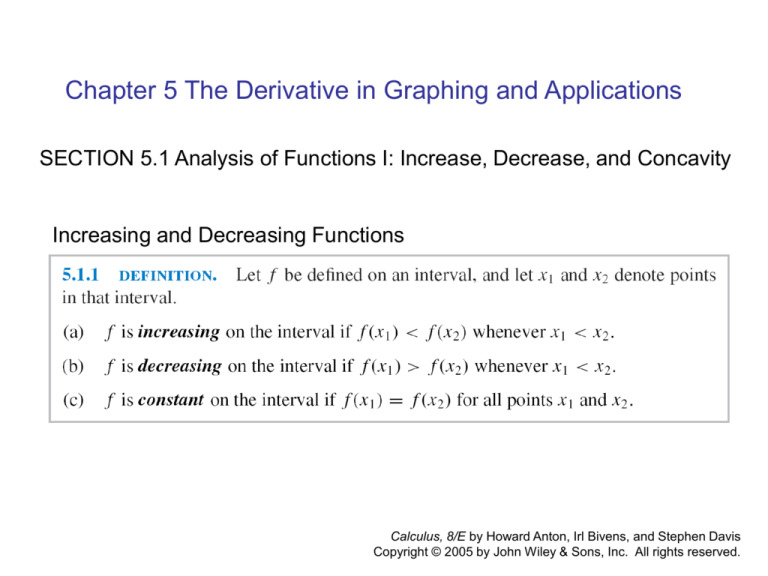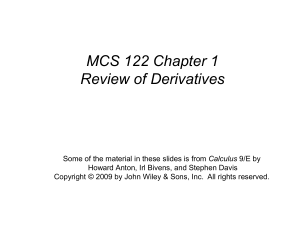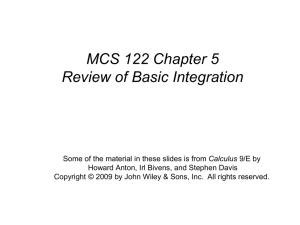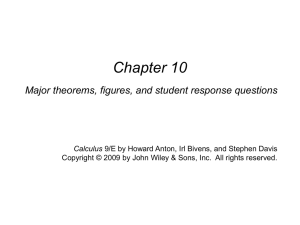
Chapter 5 The Derivative in Graphing and Applications
SECTION 5.1 Analysis of Functions I: Increase, Decrease, and Concavity
Increasing and Decreasing Functions
Calculus, 8/E by Howard Anton, Irl Bivens, and Stephen Davis
Copyright © 2005 by John Wiley & Sons, Inc. All rights reserved.
Graphs of functions
Each tangent line
Has positive slope.
Each tangent line
Has negative slope.
Each tangent line
Has zero slope.
Calculus, 8/E by Howard Anton, Irl Bivens, and Stephen Davis
Copyright © 2005 by John Wiley & Sons, Inc. All rights reserved.
Theorem
Note: Theorem 5.1.2. is applicable on any interval I on which f is continuous.
Calculus, 8/E by Howard Anton, Irl Bivens, and Stephen Davis
Copyright © 2005 by John Wiley & Sons, Inc. All rights reserved.
Example
2
Example: Find the intervals on which f ( x) x 18 x 12 is increasing and
the intervals on which it is decreasing.
Solution: f '( x) 2 x 18 2( x 9)
It follows that
f '( x) 2( x 9) 0 if x 9
f '( x) 2( x 9) 0 if x 9
By Theorem 5.1.2,
f is increasing on [9, )
f is decreasing on (,9]
Calculus, 8/E by Howard Anton, Irl Bivens, and Stephen Davis
Copyright © 2005 by John Wiley & Sons, Inc. All rights reserved.
Example
Find the intervals on which f(x)=3x4+4x3-12x2+2 is increasing and the
intervals on which it is decreasing.
Solution: Differentiating f we obtain
f’(x)=12x3+12x2-24x=12x(x+2)(x-1).
The sign of f’ can be obtained using the method of test points:
INTERVAL
X<-2
-2<x<0
0<x<1
1<x
12x(x+2)(x-1)
(-)(-)(-)
(-)(+)(-)
(+)(+)(-)
(+)(+)(+)
f’(x)
+
+
Conclusion
f is decreasing on (- , -2]
f is increasing on [- 2, 0]
f is decreasing on [0, 1]
f is increasing on [1, +)
Calculus, 8/E by Howard Anton, Irl Bivens, and Stephen Davis
Copyright © 2005 by John Wiley & Sons, Inc. All rights reserved.
Concavity
Two ways to characterize the concavity of a differentiable function f on an
open interval:
• f is concave up on an open interval if its tangent lines have increasing
slopes on that interval and is concave down if they have decreasing slopes.
• f is concave up on an open interval if its graph lies above its tangent lines
on that interval and is concave down if it lies below its tangent lines
Calculus, 8/E by Howard Anton, Irl Bivens, and Stephen Davis
Copyright © 2005 by John Wiley & Sons, Inc. All rights reserved.
Theorem
Calculus, 8/E by Howard Anton, Irl Bivens, and Stephen Davis
Copyright © 2005 by John Wiley & Sons, Inc. All rights reserved.
Example
3
Example: Find the intervals on which f ( x) x 12 is concave up and
the intervals on which it is concave down.
Solution:
f '( x) 3x 2
f ''( x) 6 x
f ''( x) 0 on the interval (0, ),
f ''( x) 0 on the interval (,0).
Thus f(x) is concave up on the interval (0, ), and concave
down on the interval (,0).
Calculus, 8/E by Howard Anton, Irl Bivens, and Stephen Davis
Copyright © 2005 by John Wiley & Sons, Inc. All rights reserved.
Inflection Points
Calculus, 8/E by Howard Anton, Irl Bivens, and Stephen Davis
Copyright © 2005 by John Wiley & Sons, Inc. All rights reserved.
Example
Find the inflection points, if any, of f(x)=x3.
Solution: Calculating the first tow derivatives of f we obtain
f’(x)=3x2
f’’(x)=6x
Since f’’(x)>0 when x>0 and f’’(x)<0 when x<0, then the function f is
concave up on the interval (0, + ), and is concave down on the
interval (- , 0). Thus there is an inflection point at x=0.
Calculus, 8/E by Howard Anton, Irl Bivens, and Stephen Davis
Copyright © 2005 by John Wiley & Sons, Inc. All rights reserved.
Example
Let f(x)=x3-3x2+1. Use the first and second derivatives of f to determine
the intervals on which f is increasing, decreasing, concave up, and
concave down. Locate all inflection points.
Solution: Calculating the first two derivatives of f we obtain
f’(x)=3x2-6x=3x(x-2)
f’’(x)=6x-6=6(x-1)
The sign analysis is shown in the next slide.
Calculus, 8/E by Howard Anton, Irl Bivens, and Stephen Davis
Copyright © 2005 by John Wiley & Sons, Inc. All rights reserved.
Example
INTERVAL
X<0
0<x<2
X>2
3x(x-2)
(-)(-)
(+)(-)
(+)(+)
INTERVAL
X<1
X>1
6(x-1)
(-)
(+)
f’(x)
+
+
f’’(x)
+
Conclusion
f is increasing on (- , 0]
f is decreasing on [0, 2]
f is increasing on [2, +)
Conclusion
f is concave down on (- , 1)
f is concave up on (1, +)
The 2nd table shown that there is an inflection point at x=1, The
inflection point is (1, -1).
Calculus, 8/E by Howard Anton, Irl Bivens, and Stephen Davis
Copyright © 2005 by John Wiley & Sons, Inc. All rights reserved.
SECTIN 5.2 Analysis of Functions II:
Relative Extrema; Graphing Polynomials
Calculus, 8/E by Howard Anton, Irl Bivens, and Stephen Davis
Copyright © 2005 by John Wiley & Sons, Inc. All rights reserved.
Critical Point
Observe that the relative extrema could occur at points where the graphs
have horizontal tangent lines, or at a point where a function is not
differentiable.
Definitions:
A critical point for a function f is a point in the domain of f at which either
the graph o f has a horizontal tangent or f not differentiable.
To distinguish between two types of critical points, we call x a stationary
point of f if f’(x)=0.
Calculus, 8/E by Howard Anton, Irl Bivens, and Stephen Davis
Copyright © 2005 by John Wiley & Sons, Inc. All rights reserved.
Theorem
The points x1, x2, x3, x4, and x5 are critical points. Of these, x1, x2, and x5 are
stationary points.
Calculus, 8/E by Howard Anton, Irl Bivens, and Stephen Davis
Copyright © 2005 by John Wiley & Sons, Inc. All rights reserved.
Example
f ( x) 3x5/3 15 x 2/3
Example: Find all critical points of
Solution: The function f is continuous every where and its derivative is
f '( x) 5 x
f '( x)
2/3
10 x
1/3
5x
2/3
10 x
1/3
5 x 10 5( x 2)
1/3
x
x1/3
5( x 2)
0 if x 2 and f '( x) is undefined if x 0.
1/3
x
Thus x=0 and x=2 are critical points and x=2 is a stationary point.
Calculus, 8/E by Howard Anton, Irl Bivens, and Stephen Davis
Copyright © 2005 by John Wiley & Sons, Inc. All rights reserved.
First Derivative Test
Calculus, 8/E by Howard Anton, Irl Bivens, and Stephen Davis
Copyright © 2005 by John Wiley & Sons, Inc. All rights reserved.
Second Derivative Test
Calculus, 8/E by Howard Anton, Irl Bivens, and Stephen Davis
Copyright © 2005 by John Wiley & Sons, Inc. All rights reserved.
Example
Example: Find the relative extrema of f ( x) 3x5 5 x3
Solution: We have
f '( x) 15x 4 15x 2 15x 2 ( x 2 1) 15x 2 ( x 1)( x 1)
f ''( x) 60 x3 30 x 30 x(2 x 2 1)
Solving f’(x)=0 yields the stationary points x=-1, x=0, and x=1.
• f’(-1)=0 and f’’(-1)<0, so f has a relative maximum at x=-1;
• f’(1)=0 and f’’(1)>0, so f has a relative minimum at x=1,
• f’(0)=0 and f’’(0)=0, then the test is inconclusive. By the first derivative
test, there is neither a relative max nor relative min at that point.
Calculus, 8/E by Howard Anton, Irl Bivens, and Stephen Davis
Copyright © 2005 by John Wiley & Sons, Inc. All rights reserved.
SECTION 5.4 Absolute Maxima and Minima
Calculus, 8/E by Howard Anton, Irl Bivens, and Stephen Davis
Copyright © 2005 by John Wiley & Sons, Inc. All rights reserved.
Theorem
5.4.2. Theorem (Extreme-Value Theorem).
If a function f is continuous on a finite closed interval [a, b] then f has
both an absolute maximum and an absolute minimum on [a, b].
5.4.3 Theorem
If f has an absolute extremum on an open interval (a, b), then it must
occur at a critical point of f.
Calculus, 8/E by Howard Anton, Irl Bivens, and Stephen Davis
Copyright © 2005 by John Wiley & Sons, Inc. All rights reserved.
Finding the Absolute Extreme
Calculus, 8/E by Howard Anton, Irl Bivens, and Stephen Davis
Copyright © 2005 by John Wiley & Sons, Inc. All rights reserved.
Example
Example: Find the absolute maximum and minimum values of the function
f ( x) 2 x3 15x 2 36 x on the interval [1, 5], and determine where these
values occur.
Solution: Since f is continuous and differentiable everywhere, the absolute
extrema must occur either at endpoints of the interval or at solutions to the
equation f’(x)=0 in the open interval (1, 5)
The equation f’(x)=0 can be written as
6 x 2 30 x 36 6( x 2 5x 6) 6( x 2)( x 3) 0
Thus, there are stationary points at x=2 and at x=3.
Calculus, 8/E by Howard Anton, Irl Bivens, and Stephen Davis
Copyright © 2005 by John Wiley & Sons, Inc. All rights reserved.
Example
Evaluating f at the endpoints, at x=2 and at x=3 yields
f (1) 23
f (2) 28
f (3) 27
f (5) 55
Thus, the absolute minimum of f on [1, 5] is 23 at x=1, and the absolute
maximum of f on [1, 5] is 55 at x=5.
Calculus, 8/E by Howard Anton, Irl Bivens, and Stephen Davis
Copyright © 2005 by John Wiley & Sons, Inc. All rights reserved.
Section 5.6 Newton’s Method
To find a root r of the equation f(x)=0,
• select an initial approximation x1. If f(x1)=0, then r=x1. Otherwise,
use the root of the tangent line to the graph of f at x1 to
approximate r. Call this intercept x2 .
x2 x1
f ( x1 )
f '( x1 )
• We can now treat x2 in the same way we did x1. If f(x2 )=0, then
r= x2 . Otherwise, we construct the tangent line to the graph of f at
x2, and take x3 to be the x-intercept of the tangent line.
f ( x2 )
f '( x2 )
Continuing in this way, we can generate a succession of values
x1,x2,, x3,,,x4…that will usually approach r. This procedure for
approximating r is called Newton’s Method.
x3 x2
Calculus, 8/E by Howard Anton, Irl Bivens, and Stephen Davis
Copyright © 2005 by John Wiley & Sons, Inc. All rights reserved.
Newton’s Method
Calculus, 8/E by Howard Anton, Irl Bivens, and Stephen Davis
Copyright © 2005 by John Wiley & Sons, Inc. All rights reserved.
Example
Example
Use Newton’s Method to approximate the real solutions of x3-x-1=0
Solution: Let f(x)=x3-x-1, so f’(x)=3x2-1 and
xn3 xn 1
xn1 xn
3xn2 1
From the graph of f in the graphing calculator, we see it has only one
real solution, and it lies between 1 and 2 since f(1)f(2)<0.
Select x1=1.5 as our first approximation. Let n=1 and x1=1.5. Then
x21.34782609
Next, let n=2 and substitue x2 to obtain x31.32520040
Continue this process until two identical approximations are
generated in succession, we have x1=1.5, x21.34782609,
x31.32520040, x41.32471817, x51.3247196, x61.3247196.
Thus, the solution is approximately x61.3247196.
Calculus, 8/E by Howard Anton, Irl Bivens, and Stephen Davis
Copyright © 2005 by John Wiley & Sons, Inc. All rights reserved.
Section 5.7 Rolle’s Theorem, Mean-Value Theorem
Calculus, 8/E by Howard Anton, Irl Bivens, and Stephen Davis
Copyright © 2005 by John Wiley & Sons, Inc. All rights reserved.
Mean-Value Theorem
Calculus, 8/E by Howard Anton, Irl Bivens, and Stephen Davis
Copyright © 2005 by John Wiley & Sons, Inc. All rights reserved.
Constant Difference Theorem
Calculus, 8/E by Howard Anton, Irl Bivens, and Stephen Davis
Copyright © 2005 by John Wiley & Sons, Inc. All rights reserved.







